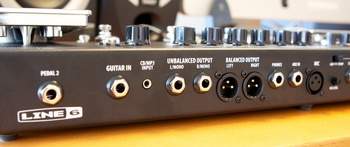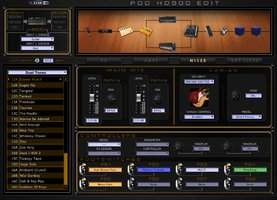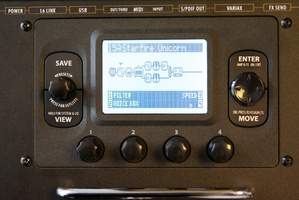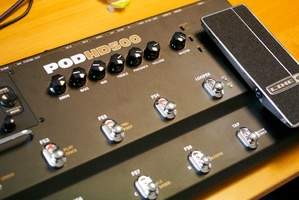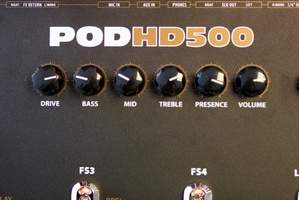The new Pod has arrived, after three long years of waiting — ever since the launch of the Pod X3, which provided the same models as its big brother, the Pod XT, and thus disappointed most guitar players. This time, Line 6 engineers have been really busy developing new models to be hosted in three new pedalboards. We tested the flagship of the range: the Pod HD 500.
The new Pod HD Series includes three products: the Pod HD 300 ($330), the Pod HD 400 ($400) and the Pod HD 500 ($500). The main differences between them are the number of integrated effects, the memory size of the loop recorder/player and the connections. We will examine thoroughly the Pod HD 500, the flagship of the series that provides about one hundred effects, a 48-second loop recorder/player, 16 new “HD” models (join the hype!) and comprehensive connections.
This new series does away with previous models which were beginning to show their age. Behind the rather surprising “HD” label, you’ll find new models that will take up the biggest part of this review.
But let’s start by unpacking the pedalboard, whose design takes after its older brother, the Pod X3 Live: a display on the left, an expression pedal on the right, pots on the top and footswtiches at the bottom. “Why change a winning horse, ” you ask? Specially considering that the Pod X3 Live had pretty good ergonomics… “Old” users won’t be put off, quite the opposite! The plastic chrome knobs (a bit cheap, I must admit) have been replaced with black knobs that feel a bit more confident. The expression pedal is also new and seems quite sturdy. On the contrary, the quality footswitches are the same and the unit is still very bulky. But considering the number of footswitches (12) and in/out connectors it has, we can hardly imagine how the manufacturer could have made it more compact… The look of Line 6 products becomes drier every year, which is not a bad thing. The Pod HD 500 has less chrome than its older brother and its dark gray metal housing makes it more trendy. The unit looks rugged enough, even though the plastic encoders (protected with a metal rod) and the multi-directional button on the right of the display seem flimsy.
Now, let’s take a look at the rear panel of the device…
Connectors, Connectors, Connectors
You’ll immediately notice that the Pod HD 500 has very comprehensive connections: the rear panel sports 20 connectors. Inputs: 1/4" jack for a second expression pedal, guitar input, 1/8" jack for a CD/MP3 player, aux input for a second instrument, XLR mic input with input level control, and Variax input for the Line 6 guitar, which provides many advantages. Note that the mic, guitar, Variax, and aux inputs can be freely assigned to one of the two signal chains. In short, you can connect two guitars and get a fully different sound for each one.
Outputs: line outs on unbalanced 1/4" TRS jacks and balanced XLR connectors, headphones out, and a so-called “L6 Link” you can use with the DT50, the manufacturer’s new amp. The L6 Link allows you to control up to four amps(!) with the footboard and vice versa. In this case, both units are synced and the amp will even have the ability to switch between different modes (class A, class A/B, biasing method, negative feedback…) depending on the preset selected in the HD500. Moreover, if you play a Variax guitar, you’ll have the possibility to control everything with your feet. Not bad, hey! The HD 500 also features a coaxial S/PDIF out delivering a 24bit/96-kHz signal.
An effect loop is also included: one stereo TRS 1/4" jack for FX send and a pair of mono TS 1/4" jacks for FX return. A selector allows you to choose stompbox or line level for the FX loop. Perfect! You also get MIDI in/out connectors as well as a USB port that allows you to use the Pod with a digital audio interface and also edit presets with the POD HD500 Edit software (Mac and Windows compatible). This software editor allows you to easily manage and edit presets thanks to its well-achieved GUI. All settings are transferred to the Pod in real time!
Do note the lack of an on/off switch, which means the device is on as soon as you connect it to the power outlet. This solution is not very practical for home use but it can avoid unwanted switch-off problems on stage!
Also notice that there are three switches on the front panel that affect the connections: one activates a pad to attenuate the guitar input level in case your active pickups are too powerful for the POD; another one, called “XLR Ground Lift, ” allows you to avoid ground loops in the XLR outs; and the last one allows you to select line or instrument signal level for the 1/4" outputs so you can connect the POD to the guitar input of your amp.
Now, let’s take a look at the settings and browsing…
Browsing
The first thing you’ll notice is that Line 6 changed the Pod’s main display. Now the information displayed, corresponding to the effects chain, is pretty clear. You can easily browse along the effects chain using the Move control on the right side of the display to activate/deactivate an effect, move it within one of the two effects chains (everything is possible), and also to select and edit it. The four rotary encoders below the display can take different functions and generally allow you to edit the four parameters displayed at the bottom of the screen. Browsing is very easy and I needed only a few minutes to learn the interface: no need to dive into the user’s manual, which you’d have to download from the Line 6 website because the product is sold only with a small printed quick guide.
The rotary encoder to the left of the display allows you to browse the presets or to display the setlists when depressed. Setlists? A setlist includes 16 banks of four presets (A, B, C, and D) for a total of 64 presets. Given that the Pod provides the user with eight setlists, you can store up to 512 presets in the unit! That ought to be enough…
You can also browse effects with the footswitches. The two footswitches on the left allow you to browse the banks while a footswitch is assigned to each preset (A, B, C, and D). The other footswitches placed above these two allow you to activate/deactivate any effect in the chain: just select them in the preset options. You can even use the four additional footswitches (FS5 to FS8) to activate/deactivate effects instead of going through the preset selection in case you have a very long effects chain. However, you also have the possibility of activating effect groups using a single footswitch. Another footswitch can be used as a tap tempo or to enable the quite precise tuner. Finally, the last footswitch activates the 48-second looper you can control with the previous footswitches, which are assigned to the following functions: undo, play once, pre/post (inserts the looper before or after the modeling), rec/overdub, play/stop, 1/2 speed, and reverse.
The expression pedal is also equipped with a footswitch that allows you to switch between two functions (Exp 1 or Exp 2, indicated by LEDs). To use it step on the top part of the pedal.
Now that you can use the Pod, let’s see an overview of the modelings provided.
Effects We Love
When it comes to effects, Line 6 resorts to the M range; more precisely to the M13 (already tested by AudioFanzine) and M9 effect boards. Thus, you get hundreds of effects (the complete list is available here: https://line6.com/podhd/effects.html) covering almost every need: from reverb to distortion, graphic EQ, octaver, synth, wah, and much weirder effects that will probably appeal only to a few of you.
We all know the quality so it’s no surprise. But it is worth mentioning that the Pod HD 500 is very versatile and it allows the user to make almost anything he wants to: chain three choruses, two delays, insert them pre or post amp… In short, the user is only limited by the global effects number (eight, which isn’t too bad at all…) and by the Pod’s processor power that manages resources dynamically. Some effects use more resources than others (the reverb and pitch shifter effects are quite demanding). The Pod will warn you when the resources threshold is exceeded (why did you use two pitch shifters, three reverbs and two amps?!) and perhaps you’ll have to make compromises. We regret the lack of a small indicator for the processor’s status. Regarding the reverbs and delays, notice that it is possible to leave the tails resonating once you deactivate the effect. That’s a pretty good thing because it allows you to make smoother preset changes.
But the real innovation has to do with the amp models!
HD Modeling (what about 3D?)
These two letters stand for 16 new models (the previous ones were a bit dated). The small number might frustrate some of the faithful Line 6 users used to having lots of amps (almost one hundred!) But the manufacturer swears new models are 10 times as precise (sic). And in the end, 16 amps could be enough if they have been chosen correctly. Here’s the list:
- Bogner® Uberschall
- Divided by 13 JRT 9/15
- Dr. Z® Route 66
- ENGL® Fireball 100
- Fender® Bassman®
- Fender® Blackface Deluxe Reverb®
- Fender® Twin Reverb®
- Gibson® EH-185
- Hiwatt® Custom 100 (DR103)
- Marshall® JCM-800 (2204)
- Marshall® JTM-45 MkII
- Mesa/Boogie® Dual Rectifier®
- Park 75
- Supro® S6616
- Vox® AC-15
- Vox® AC-30 (Top Boost)
A promising selection even if some amps are missing (for example on Orange, a JCM900 and a Roland Jazz Chorus). Line 6 will certainly extend the list with firmware updates or future Pods… However, it’s already a generous offer — and, honestly, who ever used all hundred amps of the previous Pods?
Each amp is assigned to a specific speaker and a microphone (from the seven different mics, the SM57 can be placed on or off axis). Of course, you can invert the pairs and try every possible combination. The amps’ default speakers provide the unit with a nice plug and play capability.
When it comes to speakers, you get almost everything: 1×12", 2×12", 4×12", 4×10"… Celestion V-30, G12 Greenback, Heritage, etc. The microphone offer is also comprehensive: SM 57, Sennheiser MD 409 and 421, a ribbon Coles 4038, a ribbon Royer 212, Neumann U 67 and U 87. However, except for the SM57, you don’t have the possibility to move the microphones and you can only adjust the first reflections of the room. In short, you don’t get a lot of parameters, but if the sound is right…
So, how does it sound?
In Use
We chose two guitars to test the Pod HD 500: a Gibson Les Paul Studio and a Telecaster Deluxe with P-Rails pickups.
Let’s spill our guts out first: factory presets are quite overblown, with effects everywhere and a fat make-up layer. Furthermore, it’s difficult to find your way in this mix of styles: the presets are not sorted into music styles or sound families. Most effects of the M series sound very good.
Below you can listen to five examples of (very) processed tones:

- FX 100:19
- FX 200:12
- FX 300:09
- FX 400:08
- FX 500:14
In order to get a better idea of the 16 new amp models, we bypassed all effects and loaded only the amp models with its matching speaker cabinet.
This is what it sounded like:

- Dr Z Route 66 – Telecaster00:22
- JTM-45 – Telecaster00:18
- Hiwatt – Telecaster00:29
- Bassman – Telecaster00:24
- AC30 – Telecaster00:20
- AC15 – Telecaster00:18
- Gibson 185 – Telecaster00:17
- Twin Reverb – Telecaster00:19
- Deluxe Reverb – Telecaster00:28
- Divided by 13 – Telecaster00:25
- Park 75 – Telecaster00:21
- Supro S6616 – Telecaster00:26
- ENGL – Les Paul00:20
- Mesa Boogie – Les Paul00:19
- JCM800 – Les Paul00:18
- Bogner – Les Paul00:14
The Fender amp models are rather convincing, especially the Twin Reverb with its full, bright sound and a very nice Bassman when it’s brought to the crunch limit. As for the Vox amps, the AC30 is fine, but the AC15 is a bit muddy in the low end. For the Hiwatt sound sample we played with the neck pickup first and then with the bridge pickup to check how the amp responded, and it did quite a good job.
Among the Marshall models we like the JTM-45 with its very pleasant crunch, and the Park 75 when it is not fully cranked up. On the other hand, the JCM800 disappointed us a bit because it buzzes a bit like a beehive. The last crunch sounding amps are the Gibson 185, whose great “boxy” sound convinced us, and the Divided By 13 which has an interesting somewhat dirtier tone. We fell in love with the Dr Z Route 66 (very authentic and well-balanced sound), but the Supro disappointed us a bit.
As for the hi-gain amps, you get three models: a positively aggressive Bogner, an ENGL and a Mesa Boogie with a more shallow tone. All three models sound good and the noise stays quite acceptable. Furthermore, all three amps are complementary and will surely appeal to any guitar player. It would be interesting to combine two amps in parallel in order to fatten the sound: give it a try!
To wrap it up, almost all models sound convincing enough for a pedal in this price range. Line 6 chose the amps very well and the sound range is very wide: it includes all sorts of sounds.
We recorded and mixed several guitar sounds (three takes using two amps each for a total of six different amps) with a bass guitar and drums. We used no compression, we just EQued the guitars (low-cut) to give more place to the bass guitar (recorded with the Bassman model); all in a couple of minutes. The Pod provides a quite “polished” sound that allows you to record a guitar wall quickly and easily.
Listen to the sound sample:

Conclusion
Line 6 is back with a new pedalboard with (at last!) new models. The number of amp models decreased drastically (only 16 amps are available) but the sound quality improved as well. The effects from the M9 and M13 footboards are still very good in most cases, and the Pod’s interface became a bit clearer. We just regret that the factory presets are not always usable. Finally, Line 6 provides us with a rugged footboard with comprehensive connections and nice features, like the 48-second looper. At $500, the Pod HD 500 is a good investment that will fulfill the needs of most buyers. If you think the price is a bit high, take a look at the HD 400 and 300. They provide less effects and don’t use the Dual Tone technology (two amps in parallel); the looper has less memory (24 seconds), and connections are not so comprehensive. However, their price is much lower ($330 and $400).


